Introduction
The recent improvements in communication technology have enabled billions of users in the developed and developing parts of the globe to join those already using mobile devices (Mieczakowski et al., 2011). According to the statistics provided by (Stats, 2015), the Internet users across the world are now 3,366,261,156 billion. In fact, mobile devices have put a great impact on individuals (example; teens, schools age, youth) to join this technological phenomenon. The usage of mobile devices has almost doubled over the past few years. According to (Statista, 2016), the number of mobile phone users worldwide in 2016 expected to reach 4.61 billion. Oman is one of those developing nations that have a vast penetration in using mobile devices. According to the Telecommunication Regulatory Authority in Oman (TRA, 2015); the total number of mobile subscribers has been 6,428,707 during 2015 in Oman, a figure that is almost the double of the total number of population.
Nowadays, most children acquire portable devices (example: laptop, smart phone, tablet, etc…) which can easily be connected to the World Wide Web (Buzzi, 2012). A study conducted in the United kingdom shows that almost one- third of the 3-4 years old go online “using a desktop PC, laptop or notebook , 6% go online via a tablet and 3% via a mobile phone”. The use of mobile devices has created several problems for the people of different ages. The presence of mobile communication technology has affected the structure of human relationship (Turkle, 2012). “The mobile phones can interfere with human relationships, an effect that is prominent when individuals are discussing personally meaningful topics” (Przybylski and Weinstein, 2013). A mobile device encourages access to applications (Shuler, 2009) anytime and anywhere, which increasingly makes it difficult for parents to (physically) monitor their children’s mobile device use (Campbell and Park, 2008). A study conducted by (Ravichandran, 2009) shows that the mobile usage weakens family relationships. Another study done by (Przybylski and Weinstein, 2013)says that mobile devices have an effect on the quality of face to face interaction. The usage of smart phones has affected the psychological traits including social interaction, anxiety (Lee et al., 2014) . A study done by (Boxer et al., 2015) shows that technology has reduced the growth of children.
Parents are scarcely cognizant of the risks regarding the usage of mobile devices by their children and it is very crucial to make those parents aware of the impacts of mobile devices and the Internet in particular upon their children’s social communication behavior. The parents’ ability and willingness to monitor, share and control their children’s use of online media has to face many challenges due to the portability of personalized and private nature of smart phones, which is entailed from the normal mobile phones. (Mascheroni and Ólafsson, 2014). In Sweden, young parents, aged between 25-45 years are providing their children with an accessibility to the Internet via mobile devices (Holloway et al., 2013). Other studies show that parents are less concerned about their younger children using the Internet than the older ones (McPake et al., 2010, Wagner, 2013, Brouwer et al., 2011).
More research is needed to shed light on this issue and to investigate parents’ role and perspective. There are many research studies that focus on studying the usage of mobile devices by older children and teens, see for example (Holloway et al., 2013) but younger children are under researched especially with the risks associated with the use of mobile devices. Accordingly, this research assesses parents’ awareness about the effects of mobile devices on their children’s social communication behaviors. It also investigates their happiness of the use of their children of mobile devices. This problem is being viewed from parent’s perspective, investigating children aged between 6 and12 years.
Literature Review
The use of new electronic media by children and youth has been growing due to the entertainment and communication facilities provided by these devices. (Kirwil, 2011, Lange, 2014) show that the actual use of electronic devices already begins at the age of 7–11. The parents, guardians or the caretakers equip their children with those devices, assuming that these devices support their development, learning process and observation skills (Tomczyk and Wąsiński, 2014). Sometimes the reasons parents provide their children with smart phones is to persuade them to eat (Genc, 2014). There are obviously benefits and risks at the same time. The benefits may overcome the risks, and may not be recognized until years later (Rosenberg, 2013).
There are many risks or negative impacts associated with the use of mobile devices by children. “Cyberbullying” is one of them (Schrock and Boyd, 2008, Levy et al., 2012). Cyberbullying as a term is defined as “attempts to use emotional harm and social embarrassment through the use of instant messaging, emails, social media, and text messages via cell phones.” (Berson and Berson, 2002, Henson, 2012, Twyman et al., 2010). Another study done by (Mascheroni and Ólafsson, 2014) shows that younger children are exposed to a higher rate of harm (21%). Some other statistics show that the “smartphone users (17%) and tablet users (15%) have a greater experience of any form of cyber bullying than children who do not use mobile devices (8%)”. Another study mentions that the social networks are responsible for creating an environment for cyberbullying especially for girls and young children (O’Neill and Dinh, 2015).
Another risk associated with the use of mobile devices by children is “sexual messages”. Prior studies showed that children are using mobile phones and the Internet to interact and search for sexual things (Lenhart, 2009, Livingstone, 2011). Sexual messaging can have “unintended consequences” and may result into hurtful or problematic practice for some children (Mascheroni and Ólafsson, 2014). There are also many additional risks related to the use of mobile devices. Some of them are ‘‘happy slapping” (Sieci, 2012, Chan et al., 2012) which means ” aggressive or degrading video(s) are taken by a bystander and then forwarded to other people’s phones or posted on a website” (Grigg, 2010), ‘‘cyber baiting” (Davison and Stein, 2014, Nixon, 2014) which means “the intention of harassment” (JIOW, 2015), ‘‘hating” (Delgado and Stefancic, 2014), “improper use of media in education” (Chudý et al., 2015, Glassman and Burbidge, 2014), “perilous contacts through the Internet” (Blau, 2011), “child grooming” (Nair, 2006). On the other hand, young users of social media use the Internet not only to communicate with the known people, but also with the unknown, and this could lead to the possibility of sharing sensitive data with them such as: age, location of residence, e-mail address, personal pictures, profession, hobbies and other confidential information (Tomczyk and Kopecký, 2016).
In this research, the aim is to assess the effects of mobile devices on children social communication behaviorsskills. Several studies focused on assessing social communication skills among children with autism or other special needs in general (Hansen et al., 2014, Nesterova et al., 2015, Shukla-Mehta et al., 2009). In order to assess the impacts of mobile devices on children social communication skills/behaviors, Table 1 summarizes and describes the list of social skills and behaviors found from the literature.
Table 1: Social Communication Behaviors Skills
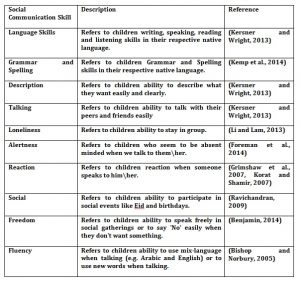
Scholars have varied opinions about the effects of mobile devices on children social communication skills and behaviors. According to (Hourcade et al., 2013), the social interaction among children improves when using tablet rather than while reading books especially in the storytelling activities. In addition, using mobile applications has a potential to support “children’s creative writing skills in order to motivate them to complete their writing tasks” (Kanala et al., 2013). Also (Kirkorian et al., 2008) mentions that the use of mobile devices by children could improve their social skills. On the other hand, a recent study done by (Genc, 2014) surveyed parents on the use of smartphones by their preschool children. Parents with a positive opinion and attitude towards smartphones said that they were a source of improvement for the children’s motor and cognitive skills, visual memory, and their adaptation to technology. While parents with a negative opinion said that they may cause a physical or mental problem in the future as they fear that their children will be introverted, will have an isolated life, or would be affected by harmful radiation.
Some studies have reported negative effects, since the use of some features in mobile devices such as animation could cause “distraction to reading comprehension and could divert the children’s attention away from learning.” (Grimshaw et al., 2007, Korat and Shamir, 2007). Apparently, the reaction of children would be somehow slower when using mobile devices and their reading skills could also be affected. Some parents confided that they are uncomfortable with the use of smartphones by their children. In addition, some parents mentioned that using these types of devices could affect the improvement or grooming of the kids. Therefore, the use of mobile devices should not be preferred by the children over their physical and developmental actions or social relationships or while communicating “with peers, family members, or teachers”. Additionally and when children use e-book for learning, they recall few details due to the additional distracted features provided in the e-book such as games and Wi-Fi (Chiong et al., 2012).
On the other hand, according to (Radesky et al., 2015), the interaction between parents and children during mealtime could prevent children from a number of issues, such as obesity (Hammons and Fiese, 2011), asthma (Fiese et al., 2011) and adolescent behavioral risks (Skeer and Ballard, 2013). The presence of mobile devices during this time could mitigate these benefits (Coon et al., 2001). Generally, mobile devices affect a parent-child interaction and are ought to be studied further to understand the effects of their usage upon the parent-child engagement in a lifelike context (Radesky et al., 2015).
Research Methodology
This research started with a general literature review in an aim to define the research objectives and questions. It carried out an exploratory case study on the Omani parents to assess their perspective on the effects of mobile devices on their children social communication behaviors. In parallel, a more focused literature review was carried out to develop a survey instrument. The research instrument has been designed based on the literature review and research objectives. Afterwards, the survey validity was conducted in two stages. The first stage was “Face Validation”, in which the questionnaire templates were distributed among Information Systems experts or other departments’ experts to collect some comments about whether the questions effectively captured the topic under investigation (Are survey questions understandable or confusing?). The second stage was “Pilot Survey Test”, in which the survey questions were distributed to 10 parents in the college to test the data for any statistically weak questions. The questionnaires were refined based upon the outcomes of the survey validation stage in order to match all the comments which were provided previously.
The questionnaire was divided into different sections to achieve different aims. The questionnaire template has been designed in four sections to emphasize a better understanding and easy way of completion. It begins with demographic (Background Information) questions of the parents; including relationship of the participant to the children, age, education, income level, marital status and number of children corresponding to their ages. The second section is about parents’ usage of mobile devices to assess if they are a mobile device user, number and types of mobile devices they own, how often they change a mobile device, and finally the amount of time they spend while using the mobile devices. The third section is the same as the second section but asks questions about the children and their usage of mobile devices. The aim of sections 2 and 3 is to assess the fluency of parents and children in using mobile devices (though this is beyond the scope of this paper). The last section is divided into two main parts: 1) social communication skills to survey parents take on the effects of mobile devices on their children social communication skills/behaviors, 2) Parents’ awareness about the effects of mobile devices on their children social communication skills/behaviors.
Findings
Neural networks (non-linear statistics (Baxt and Skora, 1996)) is comparatively a new mathematical approach for recognizing the perceptive patterns in data (Coats and Fant, 1993). It is capable of understanding complex relations in a data set. Since it tries to mimic the human brain, its performance is considered superior to the traditional causal explanatory models (Chong et al., 2013). The neural network modeling has been successfully applied in predicting bank bankruptcy, loan assessment and many other domains. Here, the study aimed to use neural networks analysis to assess key variables as possible predictors of the study’s main variables (Parents’ Happiness and Parents’ Awareness). Tables 3, 4 define key variables that have been tested.
Table 3: Parents’ happiness and independent variables

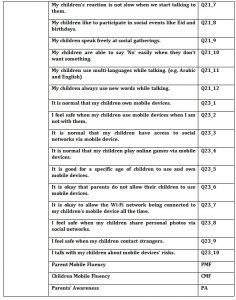
Parents’ Happiness
Here we explore how parents perceive several issues that are seen to affect their happiness regarding the usage of mobile devices by their children. The dependent variable is presented in Q24 in which it is being asked about the parents’ happiness for their children using the mobile devices. On the other hand, many independent variables may have an effect on parents’ happiness in order to achieve the study objectives. Table 3 represents all 31 independent variables. After performing the neural networks analysis, table 4 shows each variable with its importance to the base variable. The variables are in ascending order among which the first variable has the highest importance. The test, “It is normal that my children own mobile devices,” scored the highest importance. More details are in table 4. All the variables with an importance level of 44.4% and above were selected for a second test that aims to rank the top variables against each other. Results are presented in Table 5.
Table 4: The Results of Neural Networks Tests (Parents’ happiness as dependent variable)
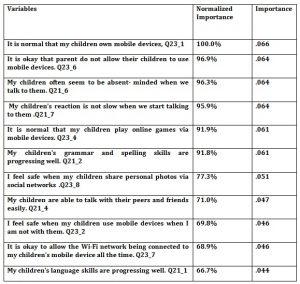
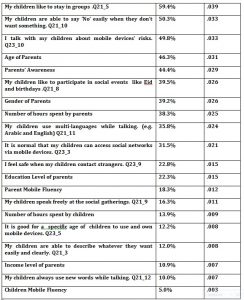
As shown in table 5, the first variable has a stronger relationship with the base variable, “I feel safe when my children use mobile devices when I am not with them,” and it scored the highest level of importance rather than the others with the normalized importance of 100%. Secondly, “My children like to stay in groups”, scored the second highest importance level, while the others were with the normalized importance level of 75.6%. On the other hand, “My children often seem to be absent minded when we talk to them” scored the least among others. More details are in table 5. A comprehensive diagram for the top sixteen variables is provided in Figure 10, which shows the top sixteen predictors with the highest percentages.
Table 5: Top sixteen vaiables
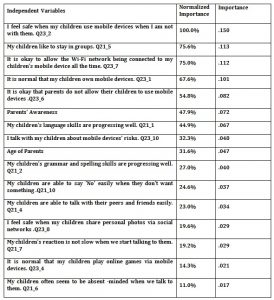
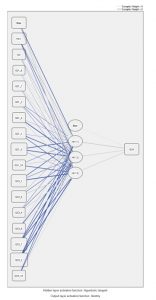
Figure 10: Relationship between (Parents’ Happiness) and Independent Variables
Parents’ Awareness
This section explores the variables influencing the awareness of the parents regarding the effects of mobile devices on children. The base variable asked about parents’ awareness regarding the effects of mobile devices on their children. Table 6 presents the chosen eight dependent variables.
Table 6: Parents’ Awareness and Independent Variables

Table 7 illustrates the results of neural network test. The variables are in ascending order. The first variables have the highest importance among others. For this test, “the number of hours spent by parents” scored the highest percentage followed by the income level and age of parents. On the other hand, parent mobile fluency was the least important among other variables. More details are in table 7. A comprehensive diagram for this test is provided in Figure 11, which shows the relationship between the base and dependent variables
Table 7: The Results of Neural Networks Tests (Parents’ Awareness as dependent variable)

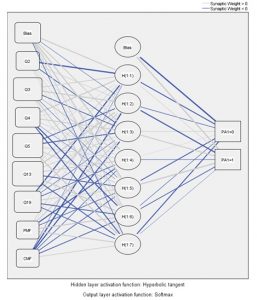
Figure 11: Relationship between (Parent Awareness) and independent variables
Discussion
The first and utmost objective of this research was to assess the happiness and awareness of parents in Oman about mobile devices’ usage and impacts upon their children. Parents Happiness and Parents Awareness were analyzed previously. Figure 12 shows a comprehensive model for both variables and its predictors, and Table 8 describes each of these predictors. As observed, only one common variable affects both variables, and that is the age of parents. The change in the age of parents may have an effect on parents’ happiness and awareness. In other words, the age of parents is more likely to affect their awareness and happiness of their children’s usage of mobile devices.
Table 8: Each Indicator with Description
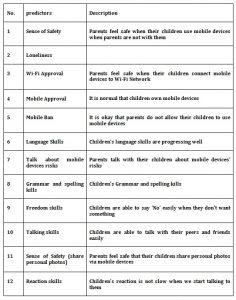
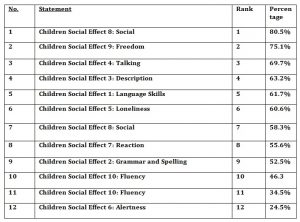
Other interpretations are as follows:
- The awareness of the parents about the effects of mobile devices’ usage among children influences their happiness.
- Parents who feel safe regarding their children’s use of mobile devices when they are not with them are more likely to be happy about their children using mobile phones.
- Parents whose children like to stay in groups are more likely to be happy regarding their children mobile devices’ usage.
- Parents who allow their children to connect to the Wi-Fi network all the time are more likely to be happy regarding their children mobile devices’ usage.
- Number of hours spent by parent has an impact upon their awareness regarding the effect of mobile devices used by their children.
Parents’ income level and age has an effect upon their awareness regarding the effect of mobile devices used by their children.
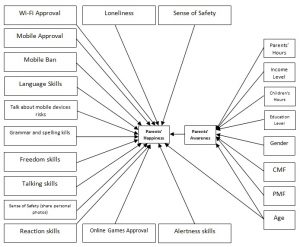
Figure 12: Parents Mobile Happiness and Awareness Model
Table 8: Ranking of social communication skills of children
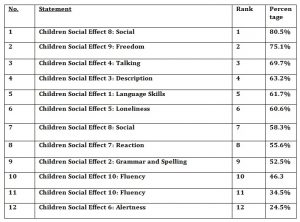
Recommendation
The last question in the questionnaire was a ‘Yes’ or ‘No’ question of which participants were asked if they are happy about their children usage of mobile devices. Interestingly, more than half (52.1%) of the parents have answered “Yes”, while the rest (47.9%) answered “No”. The parents may have a mixed opinion about their children’s mobile use. Although the reaction of the parents to their children’s social communication skills was positive in general, still 47.9% are not happy. The reason could be that parents might have felt reluctant to honestly answer the social communication section which may signal a failure in supervision. Another reason could be that parents were forced to give their children mobile devices. It could also be a mean for parents to gain peace of mind, social status, or as a social pressure from their own peers and relatives. In all cases, such discrepancies in the findings urge us to treat the results carefully. It is highly recommended for future work to apply not only a quantitative but also a qualitative method in order to assess and observe parents’ perception of mobile devices’ usage among their children.
References
- BAXT, W. G. & SKORA, J. 1996. Prospective validation of artificial neural network trained to identify acute myocardial infarction. The Lancet, 347, 12-15.
- BENJAMIN, M. 2014. An exploration of fashion information flow between mothers and their children. Texas Christian University Fort Worth, Texas.
- BERSON, I. R. & BERSON, M. J. 2002. Emerging risks of violence in the digital age: Lessons for educators from an online study of adolescent girls in the United States. Journal of School Violence, 1, 51-71.
- BISHOP, D. V. & NORBURY, C. F. 2005. Executive functions in children with communication impairments, in relation to autistic symptomatology I: Generativity. Autism, 9, 7-27.
- BLAU, I. 2011. Application use, online relationship types, self-disclosure, and Internet abuse among children and youth: implications for education and Internet safety programs. Journal of Educational Computing Research, 45, 95-116.
- BOXER, P., GROVES, C. L. & DOCHERTY, M. 2015. Video Games Do Indeed Influence Children and Adolescents’ Aggression, Prosocial Behavior, and Academic Performance A Clearer Reading of Ferguson (2015). Perspectives on Psychological Science, 10, 671-673.
- BROUWER, C., DUIMEL, M., JANSEN, S., NIKKEN, P., PARDOEN, J. & PIJPERS, R. 2011. App Noot Muis. Peuters en kleuters op het Internet: Buurtboek: Leiden.
- BUZZI, M. 2012. What are your children watching on youtube? Advances in New Technologies, Interactive Interfaces and Communicability.
- CAMPBELL, S. W. & PARK, Y. J. 2008. Social implications of mobile telephony: The rise of personal communication society. Sociology Compass, 2, 371-387.
- CHAN, S., KHADER, M., ANG, J. & TAN, E. 2012. Understanding happy slapping. Int’l J. Police Sci. & Mgmt., 14,
- CHIONG, C., REE, J., TAKEUCHI, L. & ERICKSON, I. 2012. Comparing Parent-Child Co-Reading on Print, Basic, and Enhanced E-Book Platforms: A Cooney Center Quickreport. The Joan Ganz Cooney Center. np.
- CHONG, L., ABBAS, M. M., FLINTSCH, A. M. & HIGGS, B. 2013. A rule-based neural network approach to model driver naturalistic behavior in traffic. Transportation Research Part C: Emerging Technologies, 32, 207-223.
- CHUDÝ, Š., NEUMEISTER, P., SZOTKOWSKI, R. & BUCHTOVÁ, T. 2015. The Mutual Interrelationship between Education and ICT–in the context of Knowledge and Power in the Educational Environment. Ciência e Técnica Vitivinícola, 30,
- COATS, P. K. & FANT, L. F. 1993. Recognizing financial distress patterns using a neural network tool. Financial management, 142-155.
- COON, K. A., GOLDBERG, J., ROGERS, B. L. & TUCKER, K. L. 2001. Relationships between use of television during meals and children’s food consumption patterns. Pediatrics, 107, e7-e7.
- DAVISON, C. B. & STEIN, C. H. 2014. The dangers of cyberbullying. North American Journal of Psychology, 16,
- DELGADO, R. & STEFANCIC, J. 2014. Hate speech in cyberspace. Wake Forest Law Review,
- FIESE, B. H., WINTER, M. A. & BOTTI, J. C. 2011. The ABCs of family mealtimes: Observational lessons for promoting healthy outcomes for children with persistent asthma. Child development, 82, 133-145.
- FOREMAN, P., ARTHUR‐KELLY, M., BENNETT, D., NEILANDS, J. & COLYVAS, K. 2014. Observed changes in the alertness and communicative involvement of students with multiple and severe disability following in‐class mentor modelling for staff in segregated and general education classrooms. Journal of Intellectual Disability Research, 58, 704-720.
- GENC, Z. 2014. Parents’ Perception about Mobile Technology Use of Preschool Aged Children. Social and Behavioral Sciences.
- GLASSMAN, M. & BURBIDGE, J. 2014. The dialectical relationship between place and space in education: How the internet is changing our perceptions of teaching and learning. Educational Theory, 64, 15-32.
- GRIGG, D. W. 2010. Cyber-Aggression: Definition and Concept of Cyberbullying. Australian Journal of Guidance and Counselling, 20, 143-156.
- GRIMSHAW, S., DUNGWORTH, N., MCKNIGHT, C. & MORRIS, A. 2007. Electronic books: Children’s reading and comprehension. British Journal of Educational Technology, 38, 583-599.
- HAMMONS, A. J. & FIESE, B. H. 2011. Is frequency of shared family meals related to the nutritional health of children and adolescents? Pediatrics, 127, e1565-e1574.
- HANSEN, S. G., BLAKELY, A. W., DOLATA, J. K., RAULSTON, T. & MACHALICEK, W. 2014. Children with autism in the inclusive preschool classroom: A systematic review of single-subject design interventions on social communication skills. Review Journal of Autism and Developmental Disorders, 1, 192-206.
- HENSON, B. 2012. Bullying beyond the schoolyard: Preventing and responding to cyberbullying. Nature Publishing Group.
- HOLLOWAY, D., GREEN, L. & LIVINGSTONE, S. 2013. Zero to eight: Young children and their internet use.
- HOURCADE, J. P., WILLIAMS, S. R., MILLER, E. A., HUEBNER, K. E. & LIANG, L. J. Year. Evaluation of tablet apps to encourage social interaction in children with autism spectrum disorders. In: Proceedings of the SIGCHI Conference on human factors in computing systems, 2013. ACM, 3197-3206.
- JIOW, H. J. 2015. Singapore’s Cybercrime Regulation based on Lessig’s Modalities of Constraint.
- KANALA, S., NOUSIAINEN, T. & KANKAANRANTA, M. 2013. Using a mobile application to support children’s writing motivation. Interactive Technology and Smart Education, 10, 4-14.
- KEMP, N., WOOD, C. & WALDRON, S. 2014. do i know its wrong: children’s and adults’ use of unconventional grammar in text messaging. Reading and Writing, 27, 1585-1602.
- KERSNER, M. & WRIGHT, J. A. 2013. Supporting children with communication problems: sharing the workload, Routledge.
- KIRKORIAN, H. L., WARTELLA, E. A. & ANDERSON, D. R. 2008. Media and young children’s learning. The Future of Children, 18, 39-61.
- KIRWIL, L. 2011. Polskie dzieci w Internecie: Zagrożenia i bezpieczeństwo–część 21-Częściowy raport z badań EU Kids Online przeprowadzonych wśród dzieci w wieku 9-16 lat i ich rodziców.
- KORAT, O. & SHAMIR, A. 2007. Electronic books versus adult readers: Effects on children’s emergent literacy as a function of social class. Journal of Computer Assisted Learning, 23, 248-259.
- LANGE, R., OSIECKI, J. 2014. Nastolatki wobec Internetu/Teens and Internet. Pedagogium, Warszawa.
- LEE, Y.-K., CHANG, C.-T., LIN, Y. & CHENG, Z.-H. 2014. The dark side of smartphone usage: Psychological traits, compulsive behavior and technostress. Computers in human behavior, 31, 373-383.
- LENHART, A. 2009. Teens and Sexting: How and why minor teens are sending sexually suggestive nude or nearly nude images via text messaging. Pew Internet and American Life Project. Pew Research Center, Washington, DC.
- LEVY, N., CORTESI, S., GASSER, U., CROWLEY, E., BEATON, M., CASEY, J. & NOLAN, C. 2012. Bullying in a networked era: A literature review. Berkman Center Research Publication.
- LI, M. & LAM, B. H. 2013. Cooperative learning.
- LIVINGSTONE, S., HADDON, L., GÖRZIG, A., & ÓLAFSSON, K. 2011. Risks and safety on the internet: Theperspective of European children. London: LSE, EU Kids Online.
- MASCHERONI, G. & ÓLAFSSON, K. 2014. Net children go mobile: risks and opportunities, Educatt.
- MCPAKE, J., PLOWMAN, L. & STEPHEN, C. 2010. The technologisation of childhood? Young children and technology in the home. Children & Society, 24, 63-74.
- MIECZAKOWSKI, A., GOLDHABER, T. & CLARKSON, P. 2011. Culture, Communication and Change: Summary of an investigation of the use and impact of modern media and technology in our lives.
- NAIR, A. 2006. Mobile phones and the internet: Legal issues in the protection of children. International Review of Law Computers & Technology, 20, 177-185.
- NESTEROVA, A. A., AYSINA, R. M. & SUSLOVA, T. F. 2015. Recent Technologies to Improving Social and Communication Skills in Children with ASD: Systematization of Approaches and Methods. Modern Applied Science, 9,
- NIXON, C. L. 2014. Current perspectives: the impact of cyberbullying on adolescent health. Adolescent health, medicine and therapeutics, 5,
- O’NEILL, B. & DINH, T. 2015. Mobile technologies and the incidence of cyberbullying in Seven European Countries: findings from Net children go mobile. Societies, 5, 384-398.
- PRZYBYLSKI, A. K. & WEINSTEIN, N. 2013. Can you connect with me now? How the presence of mobile communication technology influences face-to-face conversation quality. Journal of Social and Personal Relationships, 30, 237-246.
- RADESKY, J., MILLER, A. L., ROSENBLUM, K. L., APPUGLIESE, D., KACIROTI, N. & LUMENG, J. C. 2015. Maternal mobile device use during a structured parent–child interaction task. Academic pediatrics, 15, 238-244.
- RAVICHANDRAN, S. V. 2009. Mobile phones and Teenagers: Impact, Consequences and Concerns- Parents/Caregivers Perspectives. Unitec Institute of Technology.
- ROSENBERG, S. 2013. Cell phones and children: Follow the precautionary road. Pediatric nursing, 39,
- SCHROCK, A. & BOYD, D. 2008. Online threats to youth: Solicitation, harassment, and problematic content: Literature review prepared for the Internet Safety Technical Task Force. Retrieved March, 25,
- SHUKLA-MEHTA, S., MILLER, T. & CALLAHAN, K. J. 2009. Evaluating the effectiveness of video instruction on social and communication skills training for children with autism spectrum disorders: A review of the literature. Focus on Autism and Other Developmental Disabilities.
- SHULER, C. 2009. Pockets of potential: Using mobile technology to promote children’s learning.
- SIECI, D. 2012. kompetencje komunikacyjne najmlodszych: raport z badan/[red. Nauk. Piotr Siuda, Grzegorz D. Stunzaj]. Gdansk: Instytut Kultury Miejskiej.
- SKEER, M. R. & BALLARD, E. L. 2013. Are family meals as good for youth as we think they are? A review of the literature on family meals as they pertain to adolescent risk prevention. Journal of youth and adolescence, 42, 943-963.
- 2016. Number of mobile phone users worldwide from 2013 to 2019 [Online]. Available: http://www.statista.com/statistics/274774/forecast-of-mobile-phone-users-worldwide/ [Accessed].
- STATS, I. W. 2015. INTERNET USER on November 30, 2015 [Online]. Miniwatts Marketing Group. Available: http://www.internetworldstats.com/stats.htm [Accessed].
- TOMCZYK, Ł. & KOPECKÝ, K. 2016. Children and youth safety on the Internet: Experiences from Czech Republic and Poland. Telematics and Informatics, 33, 822-833.
- TOMCZYK, Ł. & WĄSIŃSKI, A. 2014. The factors and conditions of netoholism in the perspective of the diagnostic research. Media, Culture and Public Relations, 5, 4-16.
- TURKLE, S. 2012. Alone together: Why we expect more from technology and less from each other, Basic books.
- TWYMAN, K., SAYLOR, C., TAYLOR, L. A. & COMEAUX, C. 2010. Comparing children and adolescents engaged in cyberbullying to matched peers. Cyberpsychology, Behavior, and Social Networking, 13, 195-199.
- WAGNER, U. 2013. Zwischen Anspruch und Alltagsbewältigung: Medienerziehung in der Familie, Vistas.
















